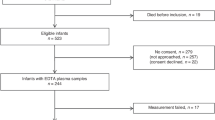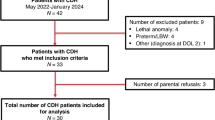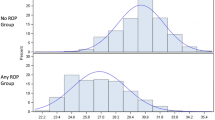Abstract
Background
To validate the findings of a single-center pilot study showing elevated urinary N-terminal B-type natriuretic peptide (NTproBNP) concentrations in preterm infants subsequently developing severe retinopathy of prematurity (ROP) in a multicenter setting across eight European and Middle East countries.
Methods
Prospective observational study in 967 preterm infants <30 weeks’ gestational age assessing the capacity of urinary NTproBNP on days of life (DOLs) 14 and 28 to predict ROP requiring treatment.
Results
Urinary NTproBNP concentrations were markedly elevated in infants who developed ROP requiring treatment (n=94) compared with survivors without ROP treatment (n=837), at both time points (median (interquartile range) DOL14: 8,950 (1,925–23,783) vs. 3,083 (1,193-17,393) vs. 816 (290-3,078) pg/ml, P<0.001) and DOL28 (2,203 (611–4,063) vs. 1,671 (254–11,340) vs. 408 (162–1,126) pg/ml, P<0.001). C-statistic of NTproBNP for treated ROP or death was 0.731 (95% confidence interval 0.654–0.774) for DOL14 and 0.683 (0.622–0.745) for DOL28 (P<0.001). Threshold scores were calculated, potentially enabling around 20% of infants with low NTproBNP scores never to be screened with ophthalmoscopy.
Conclusion
There is a strong association between early urinary NTproBNP and subsequent ROP development, which can be used to further refine subgroups of patients with high or low risk of severe ROP.
Similar content being viewed by others
Log in or create a free account to read this content
Gain free access to this article, as well as selected content from this journal and more on nature.com
or
References
Blencowe H, Lawn JE, Vazquez T, Fielder A, Gilbert C . Preterm-associated visual impairment and estimates of retinopathy of prematurity at regional and global levels for 2010. Pediatr Res 2013;74 (Suppl 1): 35–49.
Fierson WM, Capone A Jr . American Academy of Pediatrics Section on Opthalmology, American Academy of Ophthalmology. Telemedicine for evaluation of retinopathy of prematurity. Pediatrics 2015;135:e238–54.
Zepeda-Romero LC, Gilbert C . Limitations in ROP programs in 32 neonatal intensive care units in five states in Mexico. Biomed Res Int 2015;2015:712624.
Vinekar A, Jayadev C, Kumar S et al. Impact of improved neonatal care on the profile of retinopathy of prematurity in rural neonatal centers in India over a 4-year period. Eye Brain 2016;8:45–53.
Rush R, Rush S, Nicolau J, Chapman K, Naqvi M . Systemic manifestations in response to mydriasis and physical examination during screening for retinopathy of prematurity. Retina 2004;24:242–5.
Dhaliwal CA, Wright E, McIntosh N, Dhaliwal K, Fleck BW . Pain in neonates during screening for retinopathy of prematurity using binocular indirect ophthalmoscopy and wide-field digital retinal imaging: a randomised comparison. Arch Dis Child Fetal Neonatal Ed 2010;95:F146–8.
Jensen AK, Forbes BJ, Wilson LB, Prieto D, Binenbaum G . Widespread retinal hemorrhages after retinopathy of prematurity screening with scleral depression. J AAPOS 2011;15:609–11.
Cohen AM, Cook N, Harris MC, Ying GS, Binenbaum G . The pain response to mydriatic eyedrops in preterm infants. J Perinatol 2013;33:462–5.
Wade KC, Pistilli M, Baumritter A et al. Safety of retinopathy of prematurity examination and imaging in premature infants. J Pediatr 2015;167:e1002.
Agrawal Y, Patri S, Kalavakunta JK, Gupta V . Retinopathy of prematurity screening leading to cardiopulmonary arrest: fatal complication of a benign procedure. Br Med J 2016;2016 pii: bcr2016216594.
Grabska J, Walden P, Lerer T et al. Can oral sucrose reduce the pain and distress associated with screening for retinopathy of prematurity? J Perinatol 2005;25:33–5.
Nir A, Nasser N . Clinical value of NT-ProBNP and BNP in pediatric cardiology. J Card Fail 2005;11:S76–80.
Sugimoto M, Manabe H, Nakau K et al. The role of N-terminal pro-B-type natriuretic peptide in the diagnosis of congestive heart failure in children. - Correlation with the heart failure score and comparison with B-type natriuretic peptide. Circ J 2010;74:998–1005.
Lechner E, Wiesinger-Eidenberger G, Wagner O et al. Amino terminal pro B-type natriuretic peptide levels are elevated in the cord blood of neonates with congenital heart defect. Pediatr Res 2009;66:466–9.
Kurihara N, Miwa M, Matsuzaki Y et al. Usefulness of measurement of urinary N-terminal pro-brain natriuretic peptide in neonatal period. Pediatr Int 2011;53:608.
Kulkarni M, Gokulakrishnan G, Price J, Fernandes CJ, Leeflang M, Pammi M . Diagnosing significant PDA using natriuretic peptides in preterm neonates: a systematic review. Pediatrics 2015;135:e510–25.
Czernik C, Metze B, Müller C, Müller B, Bührer C . Urinary N-terminal B-type natriuretic peptide predicts severe retinopathy of prematurity. Pediatrics 2011;128:e545–9.
International Committee for the Classification of Retinopathy of Prematurity. The International Classification of Retinopathy of Prematurity revisited. Arch Ophthalmol 2005;123:991–999.
Early Treatment For Retinopathy Of Prematurity Cooperative Group. Revised indications for the treatment of retinopathy of prematurity: results of the early treatment for retinopathy of prematurity randomized trial. Arch Ophthalmol 2003;121:1684–94.
Jung JL, Wagner BD, McCourt EA et al. Validation of WINROP for detecting retinopathy of prematurity in a North American cohort of preterm infants. J AAPOS 2017;21:229–33.
Gurwin J, Tomlinson LA, Quinn GE et al. A tiered approach to retinopathy of prematurity acreening (TARP) using a weight gain predictive model and a telemedicine system. JAMA Ophthalmol 2017;135:131–136.
van Sorge AJ, Schalij-Delfos NE, Kerkhoff FT et al. Reduction in screening for retinopathy of prematurity through risk factor adjusted inclusion criteria. Br J Ophthalmol 2013;97:1143–7.
Thomas K, Shah PS, Canning R, Harrison A, Lee SK, Dow KE . Retinopathy of prematurity: risk factors and variability in Canadian neonatal intensive care units. J Neonatal Perinatal Med 2015;8:207–14.
Slidsborg C, Jensen A, Forman JL et al. Neonatal risk factors for treatment-demanding retinopathy of prematurity: a Danish national study. Ophthalmology 2016;123:796–803.
van Sorge AJ, Termote JU, Kerkhoff FT et al. Nationwide inventory of risk factors for retinopathy of prematurity in the Netherlands. J Pediatr 2014;164:494–8.
Allegaert K, Cossey V, Naulaers G, Vanhole C, Devlieger H, Casteels I . Dopamine is an indicator but not an independent risk factor for grade 3 retinopathy of prematurity in extreme low birthweight infants. Br J Ophthalmol 2004;88:309–10.
Catenacci M, Miyagi S, Wickremasinghe AC et al. Dopamine-resistant hypotension and severe retinopathy of prematurity. J Pediatr 2013;163:400–5.
Perez-Muñuzuri A, Couce-Pico ML, Baña-Souto A et al. Preclinical screening for retinopathy of prematurity risk using IGF1 levels at 3 weeks post-partum. PLoS ONE 2014;9:e88781.
Hussein MA, Coats DK, Khan H et al. Evaluating the association of autonomic drug use to the development and severity of retinopathy of prematurity. J AAPOS 2014;18:332–7.
Brueckmann M, Huhle G, Lang S et al. Prognostic value of plasma N-terminal pro-brain natriuretic peptide in patients with severe sepsis. Circulation 2005;112:527–34.
Varpula M, Pulkki K, Karlsson S, Ruokonen E, Pettila V . Predictive value of N-terminal pro-brain natriuretic peptide in severe sepsis and septic shock. Crit Care Med 2007;35:1277–83.
van Albada ME, Loot FG, Fokkema R, Roofthooft MT, Berger RM . Biological serum markers in the management of pediatric pulmonary arterial hypertension. Pediatr Res 2008;63:321–7.
Tobian AA, Sokoll LJ, Tisch DJ, Ness PM, Shan H . N-terminal pro-brain natriuretic peptide is a useful diagnostic marker for transfusion-associated circulatory overload. Transfusion 2008;48:1143–50.
Aaltonen V, Kinnunen K, Jouhilahti EM et al. Hypoxic conditions stimulate the release of B-type natriuretic peptide from human retinal pigment epithelium cell culture. Acta Ophthalmol 2014;92:740–4.
Kozulin P, Natoli R, Bumsted O'Brien KM, Madigan MC, Provis JM . The cellular expression of antiangiogenic factors in fetal primate macula. Invest Ophthalmol Vis Sci 2010;51:4298–306.
Welsh P, Woodward M, Hillis GS et al. Do cardiac biomarkers NT-proBNP and hsTnT predict microvascular events in patients with type 2 diabetes? Results from the ADVANCE trial. Diabetes Care 2014;37:2202–10.
Mutlu U, Ikram MA, Hofman A, de Jong PT, Klaver CC, Ikram MK . N-terminal pro-B-type natriuretic peptide is related to retinal microvascular damage: the Rotterdam study. Arterioscler Thromb Vasc Biol 2016;36:1698–702.
Hamano K, Nakadaira I, Suzuki J, Gonai M . N-terminal fragment of probrain natriuretic peptide is associated with diabetes microvascular complications in type 2 diabetes. Vasc Health Risk Manag 2014;10:585–9.
Darlow BA, Lui K, Kusuda S et al. International variations and trends in the treatment for retinopathy of prematurity. Br J Ophthalmol 2017 (e-pub ahead of print 7 March 2017; doi:10.1136/bjophthalmol-2016-310041).
Author information
Authors and Affiliations
Consortia
Corresponding author
Ethics declarations
Competing interests
The authors declare no conflict of interest.
Additional information
REDEXAM study group
Sinan Abu-Leil12, Benjamin Bausenhardt13, Christoph Czernik14, Uğur Dilmen15,21, Nicholas Embleton16, Zivanit Ergaz-Shaltiel12, Lara Garabedian17, Irene Lok18, Tone Nordvik19, Wes Onland18, Øivind Ringen19, Thomas Skeath16, Oliver Wagner20
12Hadassah Medical Center, Jerusalem, Israel; 13Department of Pediatrics and Adolescent Medicine, Medical University of Vienna, Vienna, Austria; 14Charité Universitätsmedizin Berlin, Berlin, Germany; 15Zekai Tahir Burak Maternity Hospital, Ankara, Turkey; 16Royal Victoria Infirmary, Newcastle upon Tyne, UK; 17Department of Development and Regeneration, Catholic University of Leuven, Leuven, Belgium; 18Emma Children’s Hospital, Academic Medical Center Amsterdam, Amsterdam, The Netherlands; 19Oslo University Hospital, Oslo, Norway; 20Kepler University Medical Center, Linz, Austria.
21Deceased.
Statement of Financial Support
The study has received financial support from the BLISS innovation grant (London, UK) and intramural funding.
Rights and permissions
About this article
Cite this article
Bührer, C., Erdeve, Ö., van Kaam, A. et al. N-terminal B-type natriuretic peptide urinary concentrations and retinopathy of prematurity. Pediatr Res 82, 958–963 (2017). https://doi.org/10.1038/pr.2017.179
Received:
Accepted:
Published:
Issue date:
DOI: https://doi.org/10.1038/pr.2017.179
This article is cited by
-
Vasoactive peptides as biomarkers for the prediction of retinopathy of prematurity
Pediatric Research (2024)
-
Diseases associated with prematurity in correlation with N-terminal pro-brain natriuretic peptide levels during the early postnatal life
European Journal of Pediatrics (2023)
-
Reference values for N-terminal Pro-brain natriuretic peptide in premature infants during their first weeks of life
European Journal of Pediatrics (2021)



